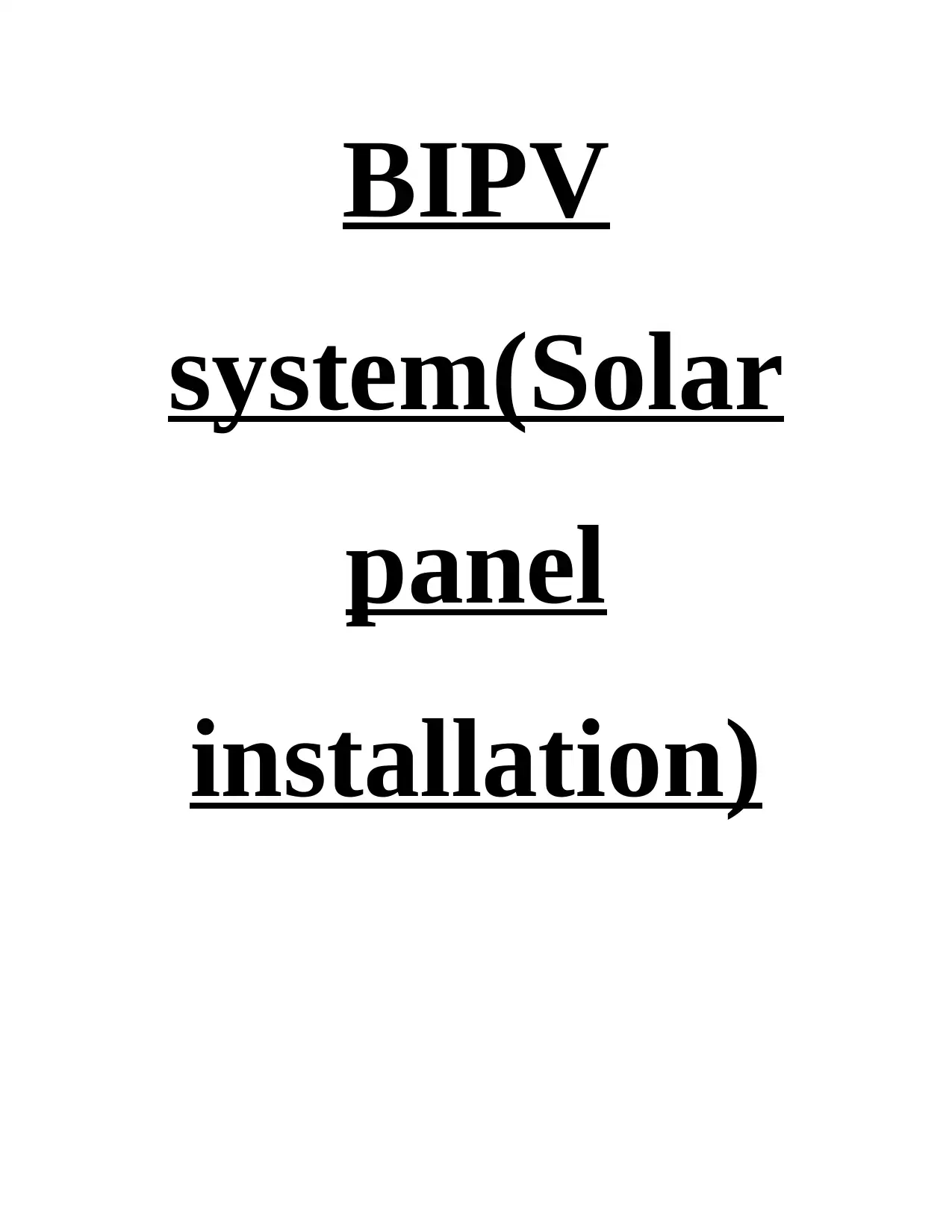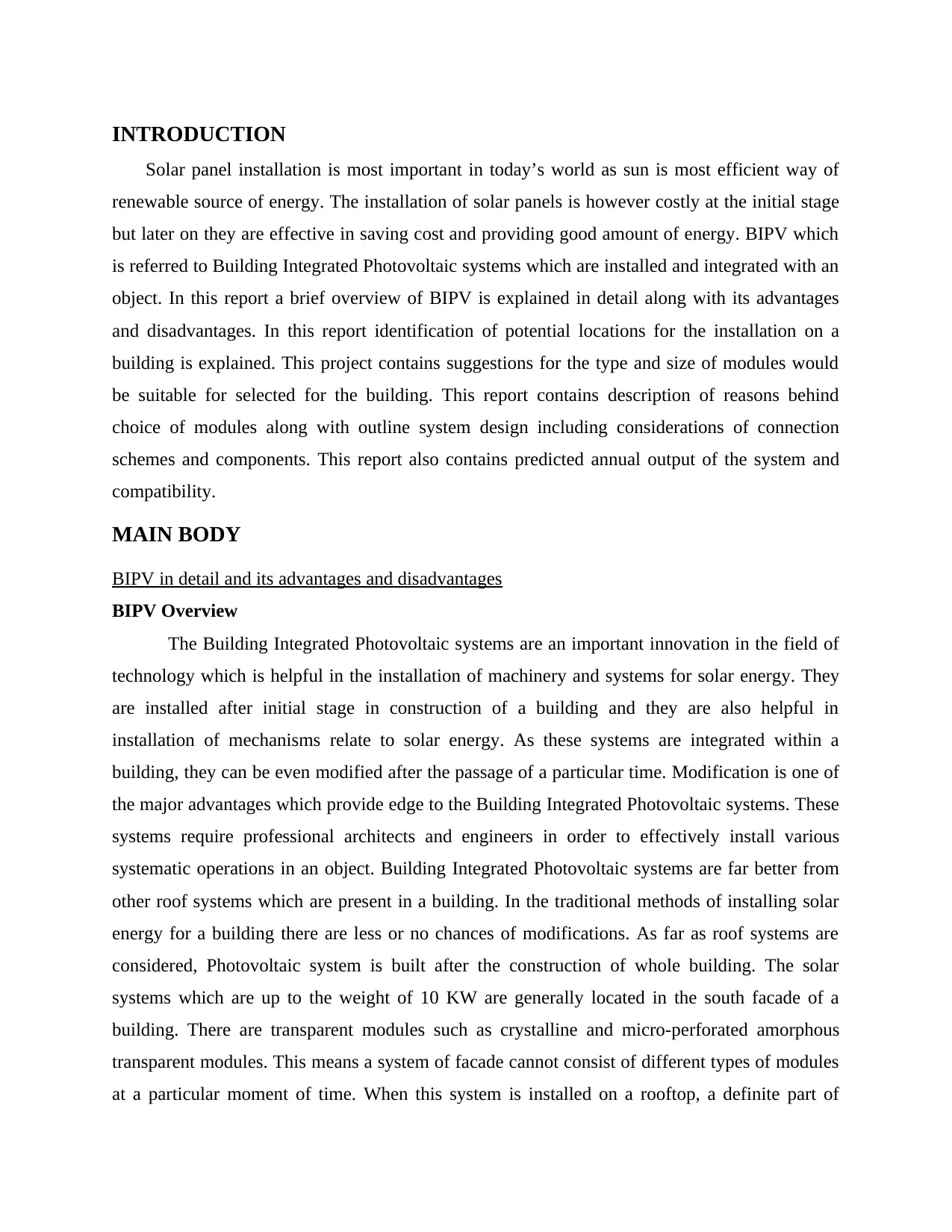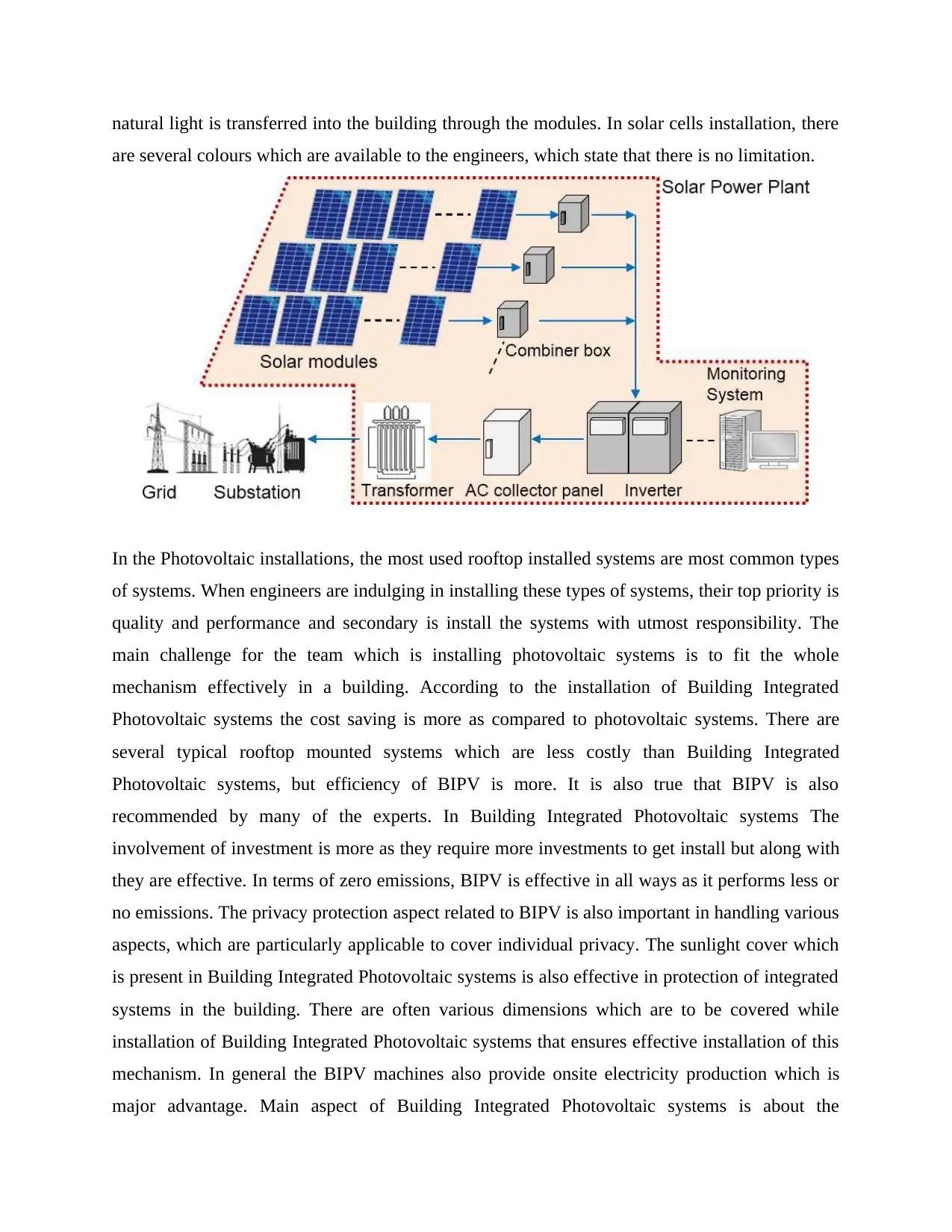BIPV System: Solar Panel Installation Report for Building Design
VerifiedAdded on 2022/12/05
|7
|1261
|274
Report
AI Summary
This report provides a comprehensive overview of Building Integrated Photovoltaic (BIPV) systems, focusing on solar panel installation within buildings. It delves into the advantages and disadvantages of BIPV, highlighting its role in renewable energy and energy efficiency. The report examines BIPV in detail, explaining how these systems integrate with building structures and their potential for modification. It discusses the benefits, such as energy supply to loads and grids, cost value, and time-saving aspects. The report also covers cost breakdowns, potential locations for installation, and system design considerations, including connection schemes and components. Furthermore, it touches upon predicted annual output and compatibility, providing a complete analysis of BIPV systems.

BIPV
system(Solar
panel
installation)
system(Solar
panel
installation)
Paraphrase This Document
Need a fresh take? Get an instant paraphrase of this document with our AI Paraphraser


Contents
INTRODUCTION...........................................................................................................................3
MAIN BODY..................................................................................................................................3
BIPV in detail and its advantages and disadvantages..................................................................3
BIPV Cost breakdown.....................................................................................................................9
CONCLUSION..............................................................................................................................16
REFERENCES..............................................................................................................................17
INTRODUCTION...........................................................................................................................3
MAIN BODY..................................................................................................................................3
BIPV in detail and its advantages and disadvantages..................................................................3
BIPV Cost breakdown.....................................................................................................................9
CONCLUSION..............................................................................................................................16
REFERENCES..............................................................................................................................17
⊘ This is a preview!⊘
Do you want full access?
Subscribe today to unlock all pages.

Trusted by 1+ million students worldwide

INTRODUCTION
Solar panel installation is most important in today’s world as sun is most efficient way of
renewable source of energy. The installation of solar panels is however costly at the initial stage
but later on they are effective in saving cost and providing good amount of energy. BIPV which
is referred to Building Integrated Photovoltaic systems which are installed and integrated with an
object. In this report a brief overview of BIPV is explained in detail along with its advantages
and disadvantages. In this report identification of potential locations for the installation on a
building is explained. This project contains suggestions for the type and size of modules would
be suitable for selected for the building. This report contains description of reasons behind
choice of modules along with outline system design including considerations of connection
schemes and components. This report also contains predicted annual output of the system and
compatibility.
MAIN BODY
BIPV in detail and its advantages and disadvantages
BIPV Overview
The Building Integrated Photovoltaic systems are an important innovation in the field of
technology which is helpful in the installation of machinery and systems for solar energy. They
are installed after initial stage in construction of a building and they are also helpful in
installation of mechanisms relate to solar energy. As these systems are integrated within a
building, they can be even modified after the passage of a particular time. Modification is one of
the major advantages which provide edge to the Building Integrated Photovoltaic systems. These
systems require professional architects and engineers in order to effectively install various
systematic operations in an object. Building Integrated Photovoltaic systems are far better from
other roof systems which are present in a building. In the traditional methods of installing solar
energy for a building there are less or no chances of modifications. As far as roof systems are
considered, Photovoltaic system is built after the construction of whole building. The solar
systems which are up to the weight of 10 KW are generally located in the south facade of a
building. There are transparent modules such as crystalline and micro-perforated amorphous
transparent modules. This means a system of facade cannot consist of different types of modules
at a particular moment of time. When this system is installed on a rooftop, a definite part of
Solar panel installation is most important in today’s world as sun is most efficient way of
renewable source of energy. The installation of solar panels is however costly at the initial stage
but later on they are effective in saving cost and providing good amount of energy. BIPV which
is referred to Building Integrated Photovoltaic systems which are installed and integrated with an
object. In this report a brief overview of BIPV is explained in detail along with its advantages
and disadvantages. In this report identification of potential locations for the installation on a
building is explained. This project contains suggestions for the type and size of modules would
be suitable for selected for the building. This report contains description of reasons behind
choice of modules along with outline system design including considerations of connection
schemes and components. This report also contains predicted annual output of the system and
compatibility.
MAIN BODY
BIPV in detail and its advantages and disadvantages
BIPV Overview
The Building Integrated Photovoltaic systems are an important innovation in the field of
technology which is helpful in the installation of machinery and systems for solar energy. They
are installed after initial stage in construction of a building and they are also helpful in
installation of mechanisms relate to solar energy. As these systems are integrated within a
building, they can be even modified after the passage of a particular time. Modification is one of
the major advantages which provide edge to the Building Integrated Photovoltaic systems. These
systems require professional architects and engineers in order to effectively install various
systematic operations in an object. Building Integrated Photovoltaic systems are far better from
other roof systems which are present in a building. In the traditional methods of installing solar
energy for a building there are less or no chances of modifications. As far as roof systems are
considered, Photovoltaic system is built after the construction of whole building. The solar
systems which are up to the weight of 10 KW are generally located in the south facade of a
building. There are transparent modules such as crystalline and micro-perforated amorphous
transparent modules. This means a system of facade cannot consist of different types of modules
at a particular moment of time. When this system is installed on a rooftop, a definite part of
Paraphrase This Document
Need a fresh take? Get an instant paraphrase of this document with our AI Paraphraser

natural light is transferred into the building through the modules. In solar cells installation, there
are several colours which are available to the engineers, which state that there is no limitation.
In the Photovoltaic installations, the most used rooftop installed systems are most common types
of systems. When engineers are indulging in installing these types of systems, their top priority is
quality and performance and secondary is install the systems with utmost responsibility. The
main challenge for the team which is installing photovoltaic systems is to fit the whole
mechanism effectively in a building. According to the installation of Building Integrated
Photovoltaic systems the cost saving is more as compared to photovoltaic systems. There are
several typical rooftop mounted systems which are less costly than Building Integrated
Photovoltaic systems, but efficiency of BIPV is more. It is also true that BIPV is also
recommended by many of the experts. In Building Integrated Photovoltaic systems The
involvement of investment is more as they require more investments to get install but along with
they are effective. In terms of zero emissions, BIPV is effective in all ways as it performs less or
no emissions. The privacy protection aspect related to BIPV is also important in handling various
aspects, which are particularly applicable to cover individual privacy. The sunlight cover which
is present in Building Integrated Photovoltaic systems is also effective in protection of integrated
systems in the building. There are often various dimensions which are to be covered while
installation of Building Integrated Photovoltaic systems that ensures effective installation of this
mechanism. In general the BIPV machines also provide onsite electricity production which is
major advantage. Main aspect of Building Integrated Photovoltaic systems is about the
are several colours which are available to the engineers, which state that there is no limitation.
In the Photovoltaic installations, the most used rooftop installed systems are most common types
of systems. When engineers are indulging in installing these types of systems, their top priority is
quality and performance and secondary is install the systems with utmost responsibility. The
main challenge for the team which is installing photovoltaic systems is to fit the whole
mechanism effectively in a building. According to the installation of Building Integrated
Photovoltaic systems the cost saving is more as compared to photovoltaic systems. There are
several typical rooftop mounted systems which are less costly than Building Integrated
Photovoltaic systems, but efficiency of BIPV is more. It is also true that BIPV is also
recommended by many of the experts. In Building Integrated Photovoltaic systems The
involvement of investment is more as they require more investments to get install but along with
they are effective. In terms of zero emissions, BIPV is effective in all ways as it performs less or
no emissions. The privacy protection aspect related to BIPV is also important in handling various
aspects, which are particularly applicable to cover individual privacy. The sunlight cover which
is present in Building Integrated Photovoltaic systems is also effective in protection of integrated
systems in the building. There are often various dimensions which are to be covered while
installation of Building Integrated Photovoltaic systems that ensures effective installation of this
mechanism. In general the BIPV machines also provide onsite electricity production which is
major advantage. Main aspect of Building Integrated Photovoltaic systems is about the

architecture which is related to its construction in a precise manner. As far as air pollution which
is a major consideration while installing these types of systems, they makes no or less noise
while operating. There is no disturbance while installing these systems and in the usage of them,
owner and the localities do not face any issue related to noise pollution. If the concern of air
pollution is taken into consideration, the photovoltaic cells are beneficial which provides a major
response to the general public. Overall performance of BIPV is also calculative and beneficial in
installing an effective system at the workplace. There are several issues related to cost of
installing Building Integrated Photovoltaic systems, however it depends on the size of building.
The size of building matters as a subject of installing several machines, there are various
purposes and objective behind the installation of Building Integrated Photovoltaic systems. The
performance and the efficiency throughout the year are maintained in a building with the help of
Building Integrated Photovoltaic systems. The advantages of Building Integrated Photovoltaic
systems are mentioned below:
Advantages of BIPV
Energy supply to loads and grids- The amount of exact energy supplied by Building Integrated
Photovoltaic systems is very much efficient. In other words, energy supplied to loads and grids
by BIPV systems is more amount of energy. This means as compared to photovoltaic cells, the
amount of energy which is supplied by Building Integrated Photovoltaic systems is effective in
providing more amount of energy. As the photovoltaic cells are not efficient enough to supply
good amount of power to loads and grids, the Building Integrated Photovoltaic systems are
capable enough to supply good amount of power.
Cost value – Installation of Building Integrated Photovoltaic systems, requires high costs in
order to effectively fit them into construction of a building. In other words the investment which
is incurred in the installation of Building Integrated Photovoltaic systems is of high amount, later
it provides high value with delivery of performance. The cost value which is involved in the
mechanisms related to the development of BIPV is high as compared to traditional methods of
installing solar cells. The Building Integrated Photovoltaic systems are also beneficial in long run
as well for a construction of a building. It also fulfils the requirement of large amount of
operations with maximum efficiency.
Time saving- In the installation of Building Integrated Photovoltaic systems, there is a lot of
saving related to time. As there is involvement of professional team, in the installation of BIPV
is a major consideration while installing these types of systems, they makes no or less noise
while operating. There is no disturbance while installing these systems and in the usage of them,
owner and the localities do not face any issue related to noise pollution. If the concern of air
pollution is taken into consideration, the photovoltaic cells are beneficial which provides a major
response to the general public. Overall performance of BIPV is also calculative and beneficial in
installing an effective system at the workplace. There are several issues related to cost of
installing Building Integrated Photovoltaic systems, however it depends on the size of building.
The size of building matters as a subject of installing several machines, there are various
purposes and objective behind the installation of Building Integrated Photovoltaic systems. The
performance and the efficiency throughout the year are maintained in a building with the help of
Building Integrated Photovoltaic systems. The advantages of Building Integrated Photovoltaic
systems are mentioned below:
Advantages of BIPV
Energy supply to loads and grids- The amount of exact energy supplied by Building Integrated
Photovoltaic systems is very much efficient. In other words, energy supplied to loads and grids
by BIPV systems is more amount of energy. This means as compared to photovoltaic cells, the
amount of energy which is supplied by Building Integrated Photovoltaic systems is effective in
providing more amount of energy. As the photovoltaic cells are not efficient enough to supply
good amount of power to loads and grids, the Building Integrated Photovoltaic systems are
capable enough to supply good amount of power.
Cost value – Installation of Building Integrated Photovoltaic systems, requires high costs in
order to effectively fit them into construction of a building. In other words the investment which
is incurred in the installation of Building Integrated Photovoltaic systems is of high amount, later
it provides high value with delivery of performance. The cost value which is involved in the
mechanisms related to the development of BIPV is high as compared to traditional methods of
installing solar cells. The Building Integrated Photovoltaic systems are also beneficial in long run
as well for a construction of a building. It also fulfils the requirement of large amount of
operations with maximum efficiency.
Time saving- In the installation of Building Integrated Photovoltaic systems, there is a lot of
saving related to time. As there is involvement of professional team, in the installation of BIPV
⊘ This is a preview!⊘
Do you want full access?
Subscribe today to unlock all pages.

Trusted by 1+ million students worldwide

systems there is a tremendous save in time. Along with saving of time, Building Integrated
Photovoltaic systems also delivers effective performance related to operations of a building. The
time saving aspect, which is beneficial for a energy production and consumption is one of the
major advantages of Building Integrated Photovoltaic systems.
Photovoltaic systems also delivers effective performance related to operations of a building. The
time saving aspect, which is beneficial for a energy production and consumption is one of the
major advantages of Building Integrated Photovoltaic systems.
1 out of 7
Related Documents
Your All-in-One AI-Powered Toolkit for Academic Success.
+13062052269
info@desklib.com
Available 24*7 on WhatsApp / Email
![[object Object]](/_next/static/media/star-bottom.7253800d.svg)
Unlock your academic potential
Copyright © 2020–2025 A2Z Services. All Rights Reserved. Developed and managed by ZUCOL.





